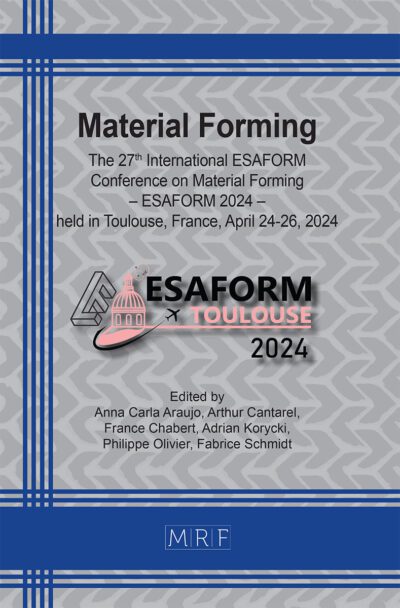Investigation of cure kinetic model and gel point for a vinylester-based SMC material
Federico Bernardi, Davide Serradimigni, Tomasz Garstka, Luca Raimondi, Lorenzo Donati
Abstract. The capability of modeling the process of Sheet Moulding Compound by numerical tools requires detailed characterization of material in different conditions. A crucial aspect of this technology involves determining the required curing time and the onset of material gelation. These aspects are essential for controlling both the molding time and the flowability of the material. The purpose of this study is to analyze the kinetic and rheological properties of a commercial vinylester-based Sheet Moulding Compound material. The Kamal-Sourour model is employed to monitor the evolution of the Degree of Cure. The model parameters are determined by fitting Differential Scanning Calorimetry data using an ordinary least squares method and validated through a secondary analysis conducted under isothermal conditions. The findings demonstrate a robust correlation with the experimental data, with a deviation of less than 4%. The gel point is evaluated by comparing the conventional methodology employed with a rotational rheometer to an innovative approach utilizing a high-resolution camera able to monitor the flow of the material while compressed. The comparison of the outcomes indicates a discrepancy of approximately 3%, demonstrating the validity of this novel approach for determining the gel point.
Keywords
Sheet Molding Compound, Gel Point, Kamal-Sourour Model, Rheology, Out-of-Autoclave Process
Published online 5/7/2025, 10 pages
Copyright © 2025 by the author(s)
Published under license by Materials Research Forum LLC., Millersville PA, USA
Citation: Federico Bernardi, Davide Serradimigni, Tomasz Garstka, Luca Raimondi, Lorenzo Donati, Investigation of cure kinetic model and gel point for a vinylester-based SMC material, Materials Research Proceedings, Vol. 54, pp 582-591, 2025
DOI: https://doi.org/10.21741/9781644903599-63
The article was published as article 63 of the book Material Forming
![]() Content from this work may be used under the terms of the Creative Commons Attribution 3.0 license. Any further distribution of this work must maintain attribution to the author(s) and the title of the work, journal citation and DOI.
Content from this work may be used under the terms of the Creative Commons Attribution 3.0 license. Any further distribution of this work must maintain attribution to the author(s) and the title of the work, journal citation and DOI.
References
[1] Falaschetti MP, Birnie Hernández J, Semprucci F, Raimondi L, Serradimigni D, Troiani E, et al. Analysis of the Crushing Behavior of Flat Composite Plates Produced by Sheet Molding Compound. Dynamic Response and Failure of Composite Materials, Springer; 2025, p. 40–8. https://doi.org/10.1007/978-3-031-77697-7_6
[2] Pulidindi K, Prakash A. Carbon Fibre Composites Market – By End-Use (Aerospace, Automotive, Wind Turbines, Sport & Leisure, Civil Engineering, Marine), By Matrix Material (Polymer [Thermosetting, Thermoplastics], Carbon, Ceramic, Metal, Hybrid) & Forecast, 2022-2030. Global Market Insights 2022:1–4.
[3] Boisse P, Akkerman R, Carlone P, Kärger L, Lomov S V., Sherwood JA. Advances in composite forming through 25 years of ESAFORM. International Journal of Material Forming 2022;15:1–30. https://doi.org/10.1007/s12289-022-01682-8
[4] Raimondi L, Brugo TM, Zucchelli A, Donati L. Effects of UD and twill reinforcements in hybrid sheet molding compound laminates. Materials Research Proceedings 2024;41:523–9. https://doi.org/10.21741/9781644903131-58
[5] Li Y, Chen Z, Xu H, Dahl J, Zeng D, Mirdamadi M, et al. Modeling and Simulation of Compression Molding Process for Sheet Molding Compound (SMC) of Chopped Carbon Fiber Composites. SAE International Journal of Materials and Manufacturing 2017;10:130–7. https://doi.org/10.4271/2017-01-0228
[6] Bernardi F, Sensini A, Raimondi L, Donati L. On the infiltration of cellular solids by sheet molding compound: process simulation and experimental validation. International Journal of Advanced Manufacturing Technology 2024;c:3745–55. https://doi.org/10.1007/s00170-024-13977-y
[7] Alnersson G, Lejon E, Zrida H, Aitomäki Y, Ljung A-L, Lundström TS. 3D flow and fibre orientation modelling of compression moulding of A-SMC: simulations and experimental validation in squeeze flow. Functional Composite Materials 2023;4. https://doi.org/10.1186/s42252-023-00049-9
[8] Raimondi L, Tomesani L, Donati L, Zucchelli A. Lattice material infiltration for hybrid metal-composite joints: Manufacturing and static strenght. Composite Structures 2021;269:114069. https://doi.org/10.1016/j.compstruct.2021.114069
[9] Romanenko V, Duhovic M, Schommer D, Hausmann J, Eschl J. Advanced process simulation of compression molded carbon fiber sheet molding compound (C-SMC) parts in automotive series applications. Composites Part A: Applied Science and Manufacturing 2022;157. https://doi.org/10.1016/j.compositesa.2022.106924
[10] Boisse P, Akkerman R, Carlone P, Kärger L, Lomov S V., Sherwood JA. Advances in composite forming through 25 years of ESAFORM. International Journal of Material Forming 2022;15. https://doi.org/10.1007/s12289-022-01682-8
[11] Tziamtzi CK, Chrissafis K. Optimization of a commercial epoxy curing cycle via DSC data kinetics modelling and TTT plot construction. Polymer 2021;230:124091. https://doi.org/10.1016/j.polymer.2021.124091
[12] Qian CC, Deshpande A, Jesri M, Groves R, Reynolds N, Kendall K. A comprehensive assessment of commercial process simulation software for compression moulding of sheet moulding compound. ESAFORM 2021 – 24th International Conference on Material Forming, 2021. https://doi.org/10.25518/esaform21.2771
[13] Müller-Pabel M, Rodríguez Agudo JA, Gude M. Measuring and understanding cure-dependent viscoelastic properties of epoxy resin: A review. Polymer Testing 2022;114. https://doi.org/10.1016/j.polymertesting.2022.107701
[14] Liu W, Jiao W, Yang F, Wang R, Li L, Jiao W. Study on rheological behavior of vinyl ester resin during thickening. Journal of Vinyl and Additive Technology 2018;24:239–47. https://doi.org/10.1002/vnl.21572
[15] Dumont P, Orgéas L, Le Corre S, Favier D. Anisotropic viscous behavior of sheet molding compounds (SMC) during compression molding. International Journal of Plasticity 2003;19:625–46. https://doi.org/10.1016/S0749-6419(01)00077-8
[16] S.Sourour M.R. Kamal. Difffrential scanning calorimetry of epoxy cure: isothermal cure kinetics. Thmnochirnica Ada, 1976;14:41–59.
[17] Hanna EG, Younes K, Amine S, Roufayel R. Exploring Gel-Point Identification in Epoxy Resin Using Rheology and Unsupervised Learning. Gels 2023;9:828.
[18] Montserrat S, Málek J. A kinetic analysis of the curing reaction of an epoxy resin. Thermochimica Acta 1993;228:47–60. https://doi.org/10.1016/0040-6031(93)80273-D












